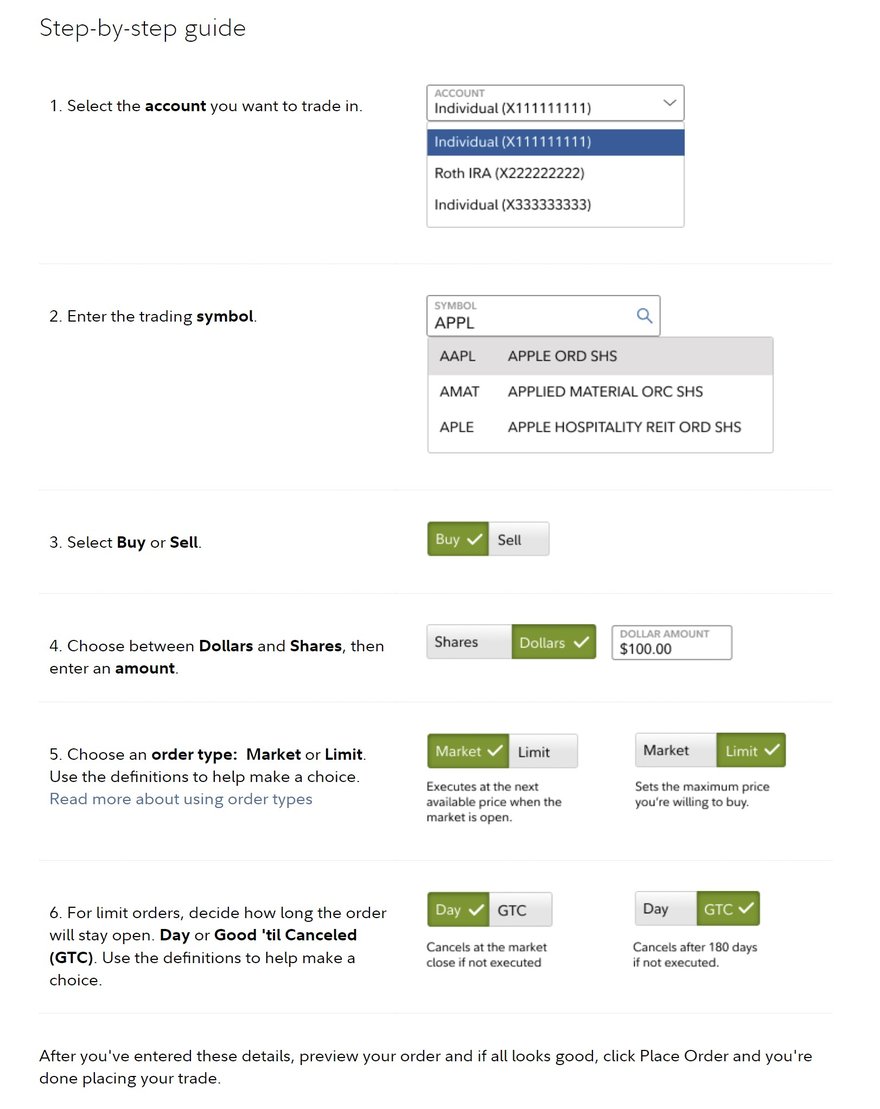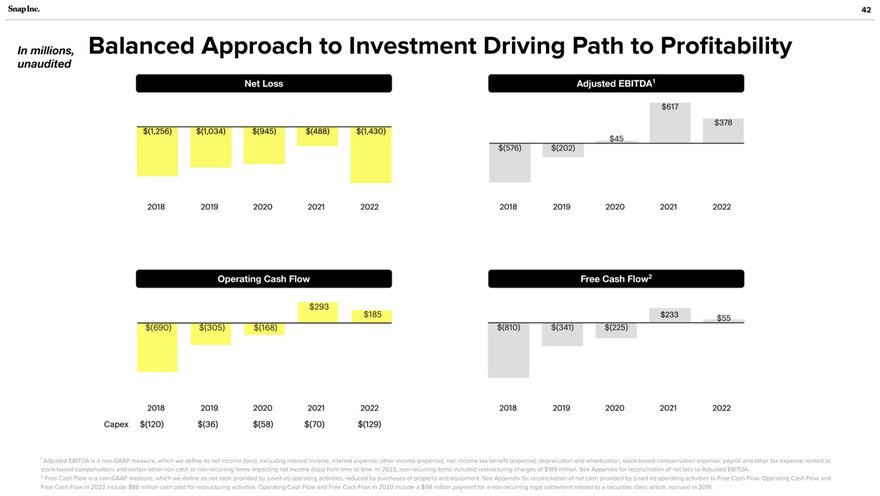Snap (SNAP 27.63%) is a technology company that empowers people to use cameras to improve their lives and communication. And it does that through its flagship product, Snapchat. The visual messaging app enables users to enhance their relationships with friends, family, and the world around them.
Snapchat has grown into one of the largest social media platforms. As of late 2023, it has more than 406 million daily active users, and 750 million people use Snapchat at least once a month.
Snapchat's highly engaged user base tilts toward a younger crowd, with over 75% of 13- to 34-year-olds in more than 25 countries using its visual messaging app. Advertisers want to reach that younger demographic, which is helping Snap monetize its platform.
The company has grand growth ambitions. It's working toward reaching 1 billion monthly active users within the next two to three years. Snap is investing heavily to expand by rolling out new features, including leveraging the power of artificial intelligence (AI) to allow users to send messages and create AI-generated selfies.
You might be among the millions who use Snap, which could have you interested in buying its stock. Here's a step-by-step guide on how to buy the social media stock and some factors to consider before adding it to your portfolio.
Stock
How to buy
How to buy Snap stock
It's relatively easy to buy shares of Snap. Here's a step-by-step guide on how to add the social media platform to your portfolio.
1. Open a brokerage account
You'll need to open and fund a brokerage account before buying shares of any company. If you don't have one yet, here are some of the best-rated brokers and trading platforms. Take your time researching the brokers to find the best one for you.
2. Figure out your budget
Before making your first trade, you'll need to determine a budget for how much money you want to invest. You'll then want to figure out how to allocate that money. The Motley Fool's investing philosophy recommends building a diversified portfolio of 25 or more stocks you plan to hold for at least five years.
Keep in mind that you don't have to get there all at once. For example, if you have $1,000 available to start investing, you might want to begin by allocating that money equally across at least 10 stocks and then grow from there.
3. Do your research
It's essential to thoroughly research a company before buying its shares. You should learn about its competitors, its balance sheet, how it makes money, and other factors to make sure you have a solid grasp on whether the company can grow value for its shareholders over the long term. Continue reading to learn more about some crucial factors to consider before investing in Snap stock.
4. Place an order
Once you've opened and funded a brokerage account, set your investing budget, and researched the stock, it's time to buy shares. The process is relatively straightforward. Go to your brokerage account's order page and fill out all the relevant information, including:
- The number of shares you want to buy or the amount you want to invest to purchase fractional shares
- The stock ticker (SNAP for Snap)
- Whether you want to place a limit order or a market order (The Motley Fool recommends using a market order since it guarantees you buy shares immediately at the market price.)
Here's a screenshot of an order page from the five-star-rated Fidelity Investment's trading platform:

Once you complete the order page, click to submit your trade and become a Snap shareholder.
Should I invest?
Should I invest in Snap?
Researching a company is a crucial step that prospective investors shouldn't skip. This process could increase your conviction that a stock will be a high performer. However, you might uncover something that changes your mind about buying shares. As part of the research process, here are some reasons you might want to invest in Snap:
- You're a fan of Snap and use its products.
- You believe Snap will continue growing its revenue and eventually start making a profit.
- You firmly believe Snap can deliver market-beating returns over the next three to five years.
- You think Snap's investments in innovation, like building augmented reality (AR) and AI features, will drive user growth and increased engagement.
- You don't currently need investments that produce dividend income.
On the other hand, here are some reasons why you might not want to buy shares of Snap:
- You're not a fan of Snap or its products.
- You don't really know what Snap does.
- You're not sure how Snap makes money.
- You're not convinced that Snap will ever start making a profit.
- You're not sure Snap can deliver market-beating returns.
- You're in or nearing retirement and need investments that produce dividend income.
Profitability
Is Snap profitable?
An essential aspect of investment research is analyzing a company's profitability. Rising profits tend to drive a rising stock price over the long term. Here's a snapshot of Snap's profitability:

As that slide shows, Snap had yet to turn the corner on profitability as of 2022, at least on a generally accepted accounting principles (GAAP) net income basis. However, the company produced positive operating cash flow, free cash flow, and adjusted earnings before interest, taxes, depreciation, and amortization (EBITDA).
Those trends continued throughout 2023. Through the third quarter, Snap had reported a net loss of more than $1 billion on $3.2 billion in revenue. However, it still produced positive free cash flow ($2 million over the trailing-12-month period).
Snap is still spending heavily to scale its business. It's focusing on its products and platforms, investing in augmented reality (AR), and making strategic acquisitions to accelerate its long-term product and technology vision. The company believes these investments will grow its revenue and free cash flow, enabling it to eventually turn the corner on profitability.
Dividends
Does Snap pay a dividend?
Snap had yet to initiate a dividend as of late 2023. It can't afford to pay dividends yet because it isn't consistently profitable and is reinvesting most of its cash flow into growing its business.
However, the company has started returning excess cash to shareholders. In late 2023, Snap's board of directors authorized a $500 million share repurchase program. Those repurchases will help offset the increase in the company's outstanding shares from its stock-based compensation program to retain employees.
ETF options
ETFs with exposure to Snap
Many investors would rather passively invest than directly own stocks they must actively monitor. Buying an exchange-traded fund (ETF) can be a great way to gain passive exposure to a company like Snap.
Exchange-Traded Fund (ETF)
According to ETF.com, 130 ETFs held 59.1 million shares of Snap as of late 2023. The Vanguard Mid-Cap Index Fund (VO 0.24%) was the largest holder, with over 8.2 million shares. However, the fund had a tiny allocation to Snap, less than 0.2% of its holdings. Investors looking for ETFs with a higher allocation to Snap have several other options, including:
- ProShares On-Demand ETF (NYSEMKT:OND): This ETF focuses on companies delivering on-demand services. Snap was its sixth-largest holding as of late 2023, at 5.2% of its assets. The fund has a 0.58% ETF expense ratio.
- Global X Metaverse ETF (NYSEMKT:VR): This ETF focuses on companies seeking to capitalize on the development and commercialization of the metaverse. Snap was the fund's seventh-largest holding in late 2023, at 5.2% of its assets. The ETF had a total expense ratio of 0.5%.
- Fidelity Disruptive Communications ETF (NYSEMKT:FDCF): The fund invests in companies seeking to disrupt the communications sector. Snap was its eighth-largest holding in late 2023, with 4.7% of its assets. The ETF had a 0.5% gross expense ratio.
Stock splits
Will Snap stock split?
Snap didn't have an upcoming stock split on the calendar as of late 2023. The social media platform has yet to split its stock since completing its initial public offering (IPO) in 2017 at $17 per share.
The company likely won't complete a stock split anytime soon. While shares skyrocketed in 2020 and 2021 (peaking at more than $75 per share), they've since come down sharply and were below their IPO price as of late 2023. Snap's stock price would likely need to significantly eclipse its prior peak before the company would consider splitting its shares.
Related investing topics
The bottom line on Snap
Snap has grown into a very popular social media platform, especially among younger users. That has made it a very attractive platform to advertisers seeking to get their products and services in front of that demographic.
While Snap has yet to turn the corner on profitability, the company believes its continued investments in new and innovative technologies, like AR and AI, will attract more users and advertisers. That should enable it to grow its revenue and eventually start making money. However, its current lack of profitability makes it a higher-risk investment.
FAQs
Investing in Snap FAQs
Can you buy shares in Snap?
Anyone with a brokerage account can buy shares of Snap. The company trades publicly on the New York Stock Exchange under the stock ticker SNAP.
Is it a good idea to invest in Snap?
Snap holds a lot of promise. It's tapping into a younger audience, which is an important demographic for advertisers. The company invests heavily in developing innovative features, which could grow its user base and engagement. That should drive revenues higher and enable the company to start making a profit eventually.
However, profits have been elusive for Snap. There's no guarantee its investment strategy will enable it to start making money. So, investing in Snap might not be a good idea for everyone, especially those seeking a stock with a high probability of producing market-beating returns.
How do I buy Snap stock?
You can buy shares of Snap through any brokerage account or online trading platform. Either open or log in to your account and fill in the order page, including:
- The number of shares you want to buy or the amount you want to invest to purchase fractional shares
- The stock ticker (SNAP for Snap)
- Whether you want to place a limit order or a market order (The Motley Fool recommends using a market order since it guarantees you buy shares immediately at the market price.)
Submit your order and become a Snap shareholder.

































































































































































































































